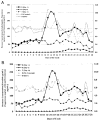Relationship between sex hormones and anterior knee laxity across the menstrual cycle
- PMID: 15235320
- PMCID: PMC1993893
- DOI: 10.1249/01.mss.0000132270.43579.1a
Relationship between sex hormones and anterior knee laxity across the menstrual cycle
Abstract
Purpose: To comprehensively quantify through daily, serial measures changes in knee laxity as a function of changing sex-hormone levels across one complete menstrual cycle.
Methods: Twenty-five females, 18 - 30 yr, body mass index < or = 30, who reported normal menstrual cycles (28-32 d) over the past 6 months participated. Participants were tested daily across one complete menstrual cycle; 5-7 cc of venous blood were withdrawn to assay serum levels of estradiol, progesterone, and testosterone. Knee laxity was measured as the amount of anterior tibial displacement at 133 N, using a standard knee arthrometer. To evaluate the relationship of knee laxity to changes in sex hormone concentrations, a multiple linear regression model with the possibility of a time delay was performed on each individual subject and the group as a whole.
Results: Individual regression equations revealed an average of 63% of the variance in knee laxity was explained by the three hormones and their interactions. All three hormones significantly contributed to the prediction equation, and the amount of variance explained was substantially greater when a time delay was considered. On average, knee laxity changed approximately 3, 4, and 4.5 d after changes in estradiol, progesterone, and testosterone, respectively. When females were analyzed as a group, only 8% of the variance in knee laxity was explained by sex-hormones levels.
Conclusion: Changes in sex hormones mediate changes in knee laxity across the menstrual cycle. However, the strength of this relationship, the relative contribution of each hormone, and the associated time delay are highly variable between women. This individual variability is consistent with the variability in menstrual cycle characteristics among women.
Figures


References
-
- Abubaker AO, Hebda PC, Gunsolley JN. Effects of sex hormones on protein and collagen content of the temporomandibular joint disc of the rat. J Oral Maxillofac Surg. 1996;54:721–727. - PubMed
-
- Charlton WPH, Coslett-Charlton LM, Cic-cotti MG. Correlation of estradiol in pregnancy and anterior cruciate ligament laxity. Clin Orthop Relat Res. 2001;1:165–170. - PubMed
-
- Dawood MY, Saxena BB. Plasma testosterone and dihydrotestosterone in ovulatory and anovulatory cycles. Am J Obstet Gynecol. 1976;126:430–435. - PubMed
-
- Dyer R, Sodek J, Heersche JM. The effect of 17 B-Estradiol on collagen and noncollagenous protein synthesis in the uterus and some periodontal tissues. Endocrinology. 1980;107:1014–1021. - PubMed
Publication types
MeSH terms
Substances
Grants and funding
- M01 RR000847-27S20988/RR/NCRR NIH HHS/United States
- M01 RR000847-28S10988/RR/NCRR NIH HHS/United States
- M01 RR000847-290988/RR/NCRR NIH HHS/United States
- M01 RR000847-270988/RR/NCRR NIH HHS/United States
- U54 HD028934/HD/NICHD NIH HHS/United States
- R03 AR047178/AR/NIAMS NIH HHS/United States
- U54 HD28934/HD/NICHD NIH HHS/United States
- R03 AR 47178/AR/NIAMS NIH HHS/United States
- M01 RR000847-300988/RR/NCRR NIH HHS/United States
- R03 AR047178-03/AR/NIAMS NIH HHS/United States
- R03 AR047178-02/AR/NIAMS NIH HHS/United States
- M01 RR000847-280988/RR/NCRR NIH HHS/United States
- R03 AR047178-01/AR/NIAMS NIH HHS/United States
- M01 RR00847/RR/NCRR NIH HHS/United States
- M01 RR000847/RR/NCRR NIH HHS/United States
LinkOut - more resources
Full Text Sources
Miscellaneous

